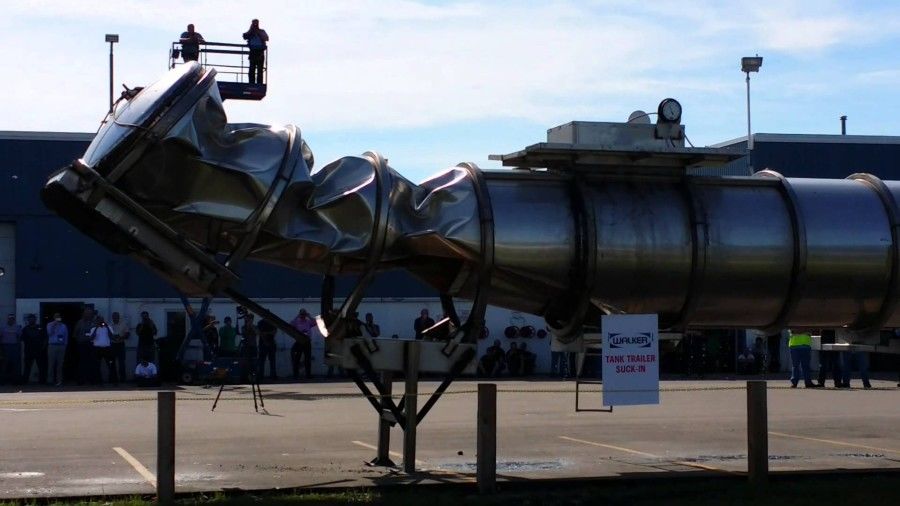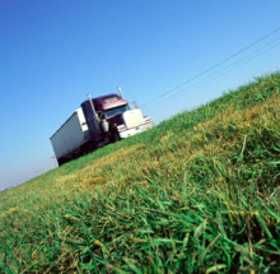New Job
Topic 19086 | Page 2
I drove a couple hundred miles today. It was awesome to be back at it. I have a great trainer so I didn't get too many bangs and bumps from the surge while shifting, since he showed me how to do it with a full load before I took over and drove awhile.
Bonus was that he took over going into this receiver and did an amazing blind side back around a building corner right to the spot we needed. (He'd been there before, a lot.)
One thing I hadn't considered too deeply was the number of detailed steps involved in loading and unloading a liquid trailer. There's a lot more than I thought there would be. Daniel B. could have warned me about this.
So far, so good.
I drove a couple hundred miles today. It was awesome to be back at it. I have a great trainer so I didn't get too many bangs and bumps from the surge while shifting, since he showed me how to do it with a full load before I took over and drove awhile.
Bonus was that he took over going into this receiver and did an amazing blind side back around a building corner right to the spot we needed. (He'd been there before, a lot.)
One thing I hadn't considered too deeply was the number of detailed steps involved in loading and unloading a liquid trailer. There's a lot more than I thought there would be. Daniel B. could have warned me about this.
So far, so good.
Haha, well its definitely infinitely tougher than anything I ever hauled at Prime. I haven't pulled a non-placarded load in what seems like forever.
But you'll get the hang of it in a month or two. You're a smart guy.
Just don't forget that vent!
Just don't forget that vent!
OS, funny story.
Im sure you know what happens with the underground tank and your tanker during a delivery, but for those who don't basically when I drop product into the underground tank the tanks fills up with product so naturally the vapors inside the tank flow into my tanker. So I give them gas, they give me vapor.
Anyways, I was at a station and I had everything hooked up properly including my vapor hose to vent and began to deliver. Typically when everything is working I deliver approximately 400 gallons per minute, more or less depending on the terrain.
But at this station it was delivering extremely slowly. After checking a few things out I discovered that their vapor system was blocked somewhere so it wouldn't circulate. In other words, if I deliver it would be the same as not venting it, and if I were to continue delivering it would also mean I'm dropping product into a tank that is literally stuffed beyond capacity with gas and vapor. After toying with it just to be sure I came to the conclusion that my theory was correct. The tank only had about 3,000 gallons in it with a total capacity of 10,000 gallons - so it was near empty.
The underground tank was so full of vapor that it actually wasnt allowing the gas to flow into it. The back-pressure was so strong it wouldn't let 8,600 gallons of gas to be gravity-dropped into it.
I ended up refusing the delivery and cited them for the violations. So yeah, don't forget to vent! And hope everything works on their end too haha!
HOS:
Hours Of Service
HOS refers to the logbook hours of service regulations.OWI:
Operating While Intoxicated
Just don't forget that vent!
I was gonna say the exact same thing. Always vent the tank before you do anything else or you're going to forget, it's only a matter of time. If you start hooking up hoses and pumps and figure, "I'll get the vent in a minute" you're going to hit that switch and forget at some point.
You might consider making a checklist if you haven't already.
HOS:
Hours Of Service
HOS refers to the logbook hours of service regulations.
Just don't forget that vent!
I was gonna say the exact same thing. Always vent the tank before you do anything else or you're going to forget, it's only a matter of time. If you start hooking up hoses and pumps and figure, "I'll get the vent in a minute" you're going to hit that switch and forget at some point.
You might consider making a checklist if you haven't already.
That is the first thing my trainer said when we went to pump off: "Do you know what happens if you pump off a tank and forget to vent?"

A checklist is a great idea. There was a checklist on the inside of the cabinet door, but if I know anything about trucking, I know there will be a day when I get a trailer that doesn't have that checklist on the inside of the cabinet door.
All of our loads are sealed. I can't break the seal on the vent until the customer signs off that it's OK to unload, so the first thing we did was go talk to the customer. I will have to figure out some way to make sure that that is the first seal I cut every time, and that immediately after cutting it, I open the vent.
Here's a funny way that I felt like a rookie yesterday. A couple of times during training, my trainer mentioned getting some B screens to keep in my truck. I didn't know what he was talking about, but I didn't want to ask and I figured it would come up again at some point. I was wondering what A screens were, and whether there were also C and maybe D screens.
We loaded high fructose corn sugar, and he said we'll have to stop by the terminal on the way out to get some B screens since this customer required them. So we went to the terminal and got some round plastic things with fine mesh in the middle. I figured that it went somewhere in the line for pumping for some unknown reason.
When we got to the place and vented the tank, my trainer pointed out that this is where the B screen went -- because bees would come for that sweet sugar and get into the tank through the mesh in the vent cap, which would screw everything up by contaminating the product, so we needed the bee screen to keep them out.
So now I know that I'll be risking bee stings just so you guys can have sugary soft drinks. And I know there are no A, C, or D screens. But I should have asked the first time it came up lol.



Terminal:
A facility where trucking companies operate out of, or their "home base" if you will. A lot of major companies have multiple terminals around the country which usually consist of the main office building, a drop lot for trailers, and sometimes a repair shop and wash facilities.
HOS:
Hours Of Service
HOS refers to the logbook hours of service regulations.
Just don't forget that vent!
OS, funny story.
Im sure you know what happens with the underground tank and your tanker during a delivery, but for those who don't basically when I drop product into the underground tank the tanks fills up with product so naturally the vapors inside the tank flow into my tanker. So I give them gas, they give me vapor.
Anyways, I was at a station and I had everything hooked up properly including my vapor hose to vent and began to deliver. Typically when everything is working I deliver approximately 400 gallons per minute, more or less depending on the terrain.
But at this station it was delivering extremely slowly. After checking a few things out I discovered that their vapor system was blocked somewhere so it wouldn't circulate. In other words, if I deliver it would be the same as not venting it, and if I were to continue delivering it would also mean I'm dropping product into a tank that is literally stuffed beyond capacity with gas and vapor. After toying with it just to be sure I came to the conclusion that my theory was correct. The tank only had about 3,000 gallons in it with a total capacity of 10,000 gallons - so it was near empty.
The underground tank was so full of vapor that it actually wasnt allowing the gas to flow into it. The back-pressure was so strong it wouldn't let 8,600 gallons of gas to be gravity-dropped into it.
I ended up refusing the delivery and cited them for the violations. So yeah, don't forget to vent! And hope everything works on their end too haha!
This is why I don't think I'm ready to haul hazmat.
HAZMAT:
Hazardous Materials
Explosive, flammable, poisonous or otherwise potentially dangerous cargo. Large amounts of especially hazardous cargo are required to be placarded under HAZMAT regulations
HOS:
Hours Of Service
HOS refers to the logbook hours of service regulations.OWI:
Operating While Intoxicated

For a new job, we need to spend more time to familiar its workflow. To know more about work content. New Job means new adventure. Be confidence to self and believe we can do it well. Fighting.
For a new job, we need to spend more time to familiar its workflow. To know more about work content. New Job means new adventure. Be confidence to self and believe we can do it well. Fighting.
If you want to win, they need more time to learn to control his own home. To learn more you win, and you can learn. The new service is the new marketing. Only those who believe they can fight better than you think.
HOS:
Hours Of Service
HOS refers to the logbook hours of service regulations.New Reply:
New! Check out our help videos for a better understanding of our forum features

















Preview:
This topic has the following tags:
Choosing A Trucking Company DOT Physical Exemptions Food Grade Tanker Medical Certification Return-to-Duty Tanker







 TT On Facebook
TT On Facebook
I was talking to a driver recently that pulled tankers before. I learned that it's not just starting, stopping, and going around bends where you can feel the surge, it's also when shifting - depending on the load. You have to actually time your shifts to be in rhythm with the flow of the load. He said if you're near capacity, the surge isn't as bad. But when there's room in the tank, the more surge you can experience. He also said that chemical loads tend to be heavier, so in his experience the chemical tanks he'd pull often had more surge because they couldn't be filled to near capacity like most food grade loads.
I experience surge on a smaller scale when I have bulk hazmat loads. We'll pull pups loaded with multiple totes (e.g. bulk corrosive) and you can feel the load push against you or side to side.
HAZMAT:
Hazardous Materials
Explosive, flammable, poisonous or otherwise potentially dangerous cargo. Large amounts of especially hazardous cargo are required to be placarded under HAZMAT regulations